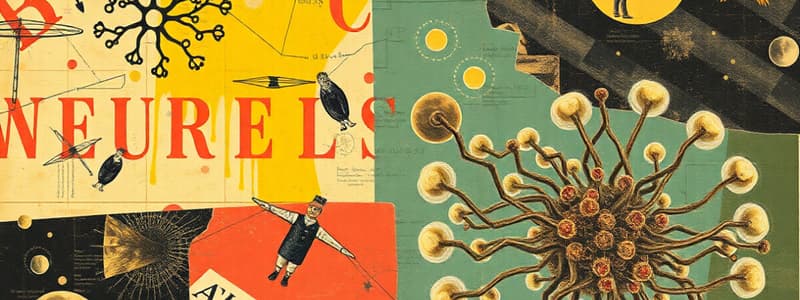Podcast
Questions and Answers
What is the primary function of beakers in the laboratory?
What is the primary function of beakers in the laboratory?
- Storing hazardous materials
- Holding reactions and filtering (correct)
- Heating substances
- Measuring small volumes of liquid
What does PPE stand for?
What does PPE stand for?
Personal Protective Equipment
What is the purpose of a microscope's fine adjustment knob?
What is the purpose of a microscope's fine adjustment knob?
To fine-tune the focus of the specimen
What are triglycerides?
What are triglycerides?
The part of the microscope that holds the slide in place is the ______.
The part of the microscope that holds the slide in place is the ______.
Plant cells typically have a central vacuole.
Plant cells typically have a central vacuole.
What are phospholipids?
What are phospholipids?
Only prokaryotic cells have a cell wall.
Only prokaryotic cells have a cell wall.
What is the structure of steroids?
What is the structure of steroids?
Which of the following is NOT a characteristic of living things?
Which of the following is NOT a characteristic of living things?
What are waxes?
What are waxes?
What role do sphingolipids play in the body?
What role do sphingolipids play in the body?
What is the formula to compute the magnification of a microscope?
What is the formula to compute the magnification of a microscope?
Match the following types of carbohydrates with their description:
Match the following types of carbohydrates with their description:
What are lipoproteins?
What are lipoproteins?
The main sugar found in the body is glucose.
The main sugar found in the body is glucose.
What are eicosanoids?
What are eicosanoids?
Match the following classes with their characteristics:
Match the following classes with their characteristics:
What are lipids primarily known for?
What are lipids primarily known for?
What defines the prokaryotic cell?
What defines the prokaryotic cell?
What is the first step in the scientific method?
What is the first step in the scientific method?
What is an independent variable?
What is an independent variable?
What is the dependent variable in the example: 'Does studying for longer hours improve exam scores?'
What is the dependent variable in the example: 'Does studying for longer hours improve exam scores?'
What does the analysis phase of the scientific method involve?
What does the analysis phase of the scientific method involve?
Flashcards are hidden until you start studying
Study Notes
Chordata
- Chordates are animals with a notochord, a dorsal nerve cord, pharyngeal slits, and a post-anal tail.
- Chordates include fish, amphibians, reptiles, birds, and mammals.
Mammalia
- Mammals are characterized by hair or fur, mammary glands, three middle ear bones, and a four-chambered heart.
- Examples of mammals include humans, dogs, cats, and whales.
Aves
- Birds are characterized by feathers, wings, hollow bones, and being warm-blooded.
- Examples of birds include eagles, sparrows, and penguins.
Reptilia
- Reptiles are characterized by scaly skin, being cold-blooded, and laying eggs.
- Examples of reptiles include snakes, lizards, and turtles.
Amphibia
- Amphibians are characterized by moist skin, the ability to live on land and in water, and being cold-blooded.
- Examples of amphibians include frogs, toads, and salamanders.
Actinopterygii
- Ray-finned fish have a bony skeleton, thin, bony scales.
- Examples of ray-finned fish include salmon, goldfish, and tuna.
Chondrichthyes
- Cartilaginous fish have a cartilaginous skeleton and tough skin.
- Examples of cartilaginous fish include sharks, rays, and skates.
Porifera
- Sponges are simple multicellular animals without true tissues
- They are filter feeders.
- Examples include bath sponges and glass sponges.
Cnidaria
- Cnidarians have radial symmetry, stinging cells, and a gastrovascular cavity.
- Examples include jellyfish, sea anemones, and coral reefs.
Insecta
- Insects have six legs, three body segments, and usually wings.
- Examples include butterflies, beetles, and ants.
Arachnida
- Arachnids have eight legs and two body segments.
- Examples include spiders, ticks, and scorpions.
Crustacea
- Crustaceans have jointed legs, a hard exoskeleton, and gills.
- Examples include crabs, lobsters, and shrimp.
Platyhelminthes
- Flatworms have bilateral symmetry, are acoelomate, and are parasitic or free-living.
- Examples include tapeworms and planarians.
Mollusca
- Molluscs are diverse in body plans and have a mantle, a shell (often present).
- Examples include snails, clams, octopuses, and squids.
Nematoda
- Roundworms have an unsegmented body, are pseudocoelomate, and are often parasitic.
- Examples include ascaris and hookworms.
Annelida
- Segmented worms have bilateral symmetry, a true coelom, and a closed circulatory system.
- Examples include earthworms and leeches.
Scientific Method
- The scientific method consists of observation, question, hypothesis, experiment, data collection, analysis, and conclusion.
Independent and Dependent Variables
- The independent variable is manipulated or changed in an experiment.
- The dependent variable is measured to see if it changes as a result of the independent variable.
Studying That Suits You
Use AI to generate personalized quizzes and flashcards to suit your learning preferences.



